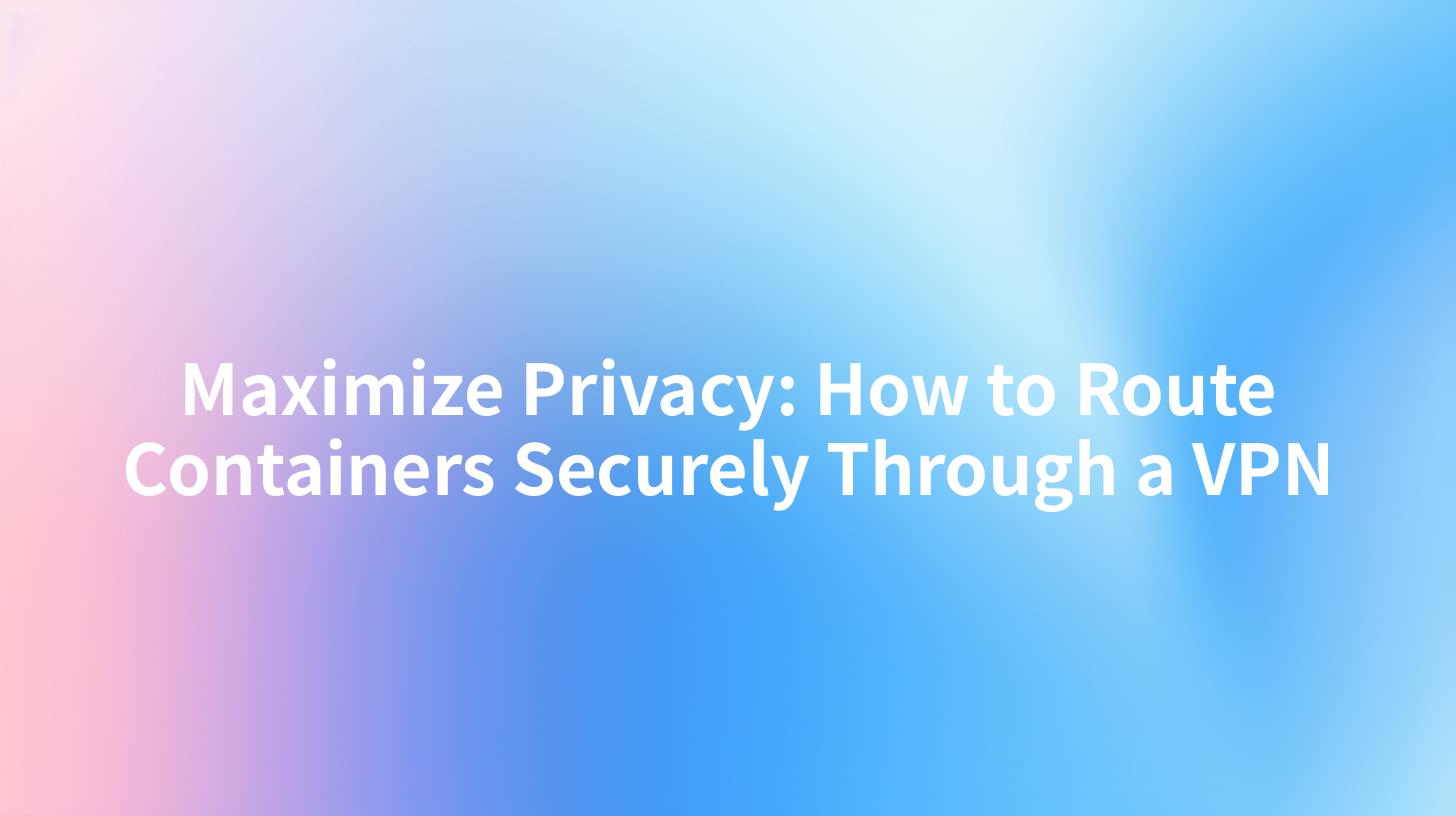Maximize Privacy: How to Route Containers Securely Through a VPN

Open-Source AI Gateway & Developer Portal
In the modern digital landscape, ensuring privacy and security in data transmission is paramount. With the rise of containerization as a key technology in software development and deployment, the need for secure routing of these containers has become increasingly important. One of the most effective ways to achieve this is by using a VPN. In this comprehensive guide, we will delve into the intricacies of routing containers securely through a VPN, discussing the best practices, potential challenges, and the role of APIPark in this process.
Understanding VPNs and Secure Routing
What is a VPN?
A VPN, or Virtual Private Network, creates a secure and encrypted connection over a public network such as the internet. This technology allows users to send and receive data across shared or public networks as if their computing devices were directly connected to a private network.
Secure Routing with VPNs
Secure routing through a VPN involves routing network traffic from containers through a VPN tunnel. This ensures that the data transmitted between containers remains encrypted and secure, protecting it from potential eavesdroppers and attackers.
The Importance of Container Privacy
Why Container Privacy Matters
Containers, which encapsulate an application's code, configurations, and dependencies, have become a cornerstone of modern application development. Ensuring the privacy of these containers is crucial for several reasons:
- Data Security: Sensitive data stored within containers must be protected from unauthorized access.
- Compliance: Many industries are subject to regulatory requirements that demand secure data handling.
- Trust: Maintaining the privacy of containers helps build trust with users and stakeholders.
Setting Up a Secure VPN for Container Routing
Choosing the Right VPN Solution
When setting up a VPN for container routing, it's essential to choose a reliable and secure VPN solution. Here are some key considerations:
- Encryption Standards: Ensure the VPN uses strong encryption standards, such as AES-256.
- Authentication Methods: Look for VPN solutions that offer robust authentication methods, like multi-factor authentication.
- Network Performance: A VPN with good network performance ensures minimal latency and high throughput.
Configuring Containers for VPN Routing
Once you have selected a VPN solution, you'll need to configure your containers to route traffic through the VPN. This process varies depending on the container runtime and operating system. Below is a general outline:
- Install VPN Client: Install the VPN client on the host machine or within the container.
- Configure VPN Connection: Set up the VPN connection using the provided configuration files or through the container's environment variables.
- Test Connection: Verify that the VPN connection is working correctly by checking the IP address assigned to the container.
APIPark is a high-performance AI gateway that allows you to securely access the most comprehensive LLM APIs globally on the APIPark platform, including OpenAI, Anthropic, Mistral, Llama2, Google Gemini, and more.Try APIPark now! 👇👇👇
Best Practices for Secure Container Routing
Regularly Update VPN Software
Keeping your VPN software up to date is crucial for maintaining security. Regular updates can patch vulnerabilities and improve performance.
Use Strong Encryption Keys
Use strong encryption keys for your VPN connections. Avoid default or weak keys, as they can be easily compromised.
Monitor VPN Traffic
Regularly monitor VPN traffic for any unusual patterns or anomalies that could indicate a security breach.
Implement Network Policies
Implement network policies to control and restrict access to containers and their resources. This can help prevent unauthorized access and data breaches.
Challenges and Solutions in Secure Container Routing
Network Latency
One of the challenges of using a VPN for container routing is network latency. This can be mitigated by choosing a VPN provider with servers located close to your container hosts.
Bandwidth Usage
VPNs can consume a significant amount of bandwidth. To manage this, consider implementing bandwidth throttling and prioritizing critical traffic.
Scalability
As your container infrastructure grows, ensuring scalability in VPN configuration becomes more challenging. Utilizing a centralized management system like APIPark can help streamline the process.
The Role of APIPark in Secure Container Routing
APIPark Overview
APIPark is an open-source AI gateway and API management platform designed to help developers and enterprises manage, integrate, and deploy AI and REST services with ease. Its features make it an excellent tool for enhancing the security and privacy of container routing through a VPN.
Key Features of APIPark in Secure Container Routing
- API Gateway Functionality: APIPark can serve as an API gateway, allowing you to control and secure the communication between containers and external services.
- Policy-Based Access Control: Implement fine-grained access control policies to ensure that only authorized containers can access sensitive data.
- Traffic Monitoring and Logging: APIPark provides detailed logs and analytics, allowing you to monitor and investigate VPN traffic for any security incidents.
Conclusion
Routing containers securely through a VPN is a critical step in ensuring the privacy and security of your data. By following the best practices outlined in this guide and leveraging tools like APIPark, you can create a robust and secure container routing infrastructure.
FAQs
1. Can I use a regular VPN for container routing? Yes, you can use a regular VPN for container routing
🚀You can securely and efficiently call the OpenAI API on APIPark in just two steps:
Step 1: Deploy the APIPark AI gateway in 5 minutes.
APIPark is developed based on Golang, offering strong product performance and low development and maintenance costs. You can deploy APIPark with a single command line.
curl -sSO https://download.apipark.com/install/quick-start.sh; bash quick-start.sh

In my experience, you can see the successful deployment interface within 5 to 10 minutes. Then, you can log in to APIPark using your account.

Step 2: Call the OpenAI API.
